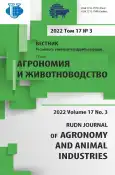Cow reproduction rates with varying inbreeding degrees
- Autores: Rudenko O.V.1
-
Afiliações:
- Nizhny Novgorod Research Agricultural Institute - Branch of «Federal Agricultural Research Center of the North-East named N.V. Rudnitskogo»
- Edição: Volume 17, Nº 3 (2022)
- Páginas: 360-372
- Seção: Animal breeding
- URL: https://journal-vniispk.ru/2312-797X/article/view/315632
- DOI: https://doi.org/10.22363/2312-797X-2022-17-3-360-372
- ID: 315632
Citar
Texto integral
Resumo
The evaluation of the breeding work results carried out, the identification of optimal systems for the animal’s selection, including related ones, have always been relevant. The purpose was to study the influence of various inbreeding degrees on reproductive abilities and their selection and genetic parameters in Holstein cows. The research was carried out on the basis of ‘Pushkinskoe’ Breeding Plant, Nizhny Novgorod region. At the earliest age, heifers were inseminated in the group with recent inbreeding (14.87 months), for this reason they had the lowest weight at the first insemination - 4 25.7 kg. Cows in the group with recent inbreeding had the shortest service period (108.9 days), the longest service period was in the group with close inbreeding (152.6 days). The variability of live weight during the first insemination and fertilization in all groups was at a low level (Cv = 5,22…8,25 %). The duration of the service period after first lactation in all groups, except for the group of close inbreeding, had a variation of about 45 %, in the group with close inbreeding it was 1.5 times higher. Despite its small number, the group of close inbreeding turned out to be the most variable in all indicators. An increase in the age of the first fertilization of heifers in the group of close inbreeding leads to an increase in the duration of the service period (r = 0.335). However, there is practically no connection between these indicators in the other groups. Many of the studied indicators had a weak positive or negative relationship with each other. Among the resulting young, more than half were heifers, in groups with different inbreeding degrees this indicator varied from 63.3 to 66.7 %, in the group with outbred animals it was 69.4 %. Twins were registered 2 times and only in the group with a recent inbreeding degree. Stillbirth in all groups was at a fairly low level - 5 .7…6.7 %, in the group with a close inbreeding degree no cases of stillborn calves were detected. The birth of calves with congenital deformities and pathologies from related mating was not observed. Thus, in the conducted studies, inbreeding had no negative impact on the cow’s reproductive qualities even to a close degree.
Palavras-chave
Sobre autores
Oksana Rudenko
Nizhny Novgorod Research Agricultural Institute - Branch of «Federal Agricultural Research Center of the North-East named N.V. Rudnitskogo»
Autor responsável pela correspondência
Email: oks-rud76@mail.ru
ORCID ID: 0000-0002-8355-1048
Candidate of Аgricultural Sciences, Senior Researcher, Livestock department
38 Central st., Selektsionnaya stantsiya v., Kstovsky district, Nizhny Novgorod region, 607686, Russian FederationBibliografia
- Martynova AY. Reproductive qualities of cows of different genotypes. Vestnik biotekhnologii. 2016; (3):3—7. (In Russ.).
- Altergot VV. Vliyanie prodolzhitel’nosti fiziologicheskikh periodov korov golshtinskoi porody na ikh vosproizvoditel’nye funktsii i khozyaistvenno-biologicheskie pokazateli potomstva [The effect of the duration of physiological periods of Holstein cows on their reproductive functions and economic and biological indicators of offspring] [Dissertation]. Moscow; 2013. (In Russ.).
- Mishkhozhev AA. Effects of paratypical factors on economically useful signs of Holstein cattle. In: Priority directions of development of modern science of young agricultural scientists: conference proceedings. 2016. р.652—654. (In Russ.).
- Novikova N, Purezki V, Fedoseeva N, Perchina O. Reproductive gualities of repair heifers in connection with the age at insemination. Journal of dairy and beef cattle breeding. 2010; (8):34—35. (In Russ.).
- Baimishev HB. Reproductive abilities of Holstein heifers. Proceedings of Nizhnevolzskiy agrouniversity complex: science and higher vocational education. 2013; (2):146—150. (In Russ.).
- Velmatov А, Erzamaev А, Tishkina Т, Hamza A-IAA, Velmatov А. Productive traits of crossbreds of Simmental and Holstein breeds. Head of animal breeding. 2018; (1):43—50. (In Russ.).
- Baryshnikova KV. Breeding characteristics of cows and their heritability in families. Journal of dairy and beef cattle breeding. 1988; (2):50—51. (In Russ.).
- Belokurov SG. Puti sovershenstvovaniya plemennykh i produktivnykh kachestv krupnogo rogatogo skota [Fertilization of cows depending on the types of selection]. In: Ways to improve breeding and productive qualities of cattle: conference proceedings. 1983. р.106—110. (In Russ.).
- Nedashkovsky IS, Sermyagin AA, Bogdanova TV, Ermilov AN, Yanchukov IN, Zinovieva NA. Evaluation of inbreeding effect for milk production and fertility traits black-and-white cattle improved by Holstein breed. Animal and dairy science. 2018; (7):17—22. (In Russ.). doi: 10.25632/MMS.2018.7.21450
- Doekes HP, Veerkamp RF, Bijma P, de Jong G, Hiemstra SJ, Windig JJ. Inbreeding depression due to recent and ancient inbreeding in Dutch Holstein–Friesian dairy cattle. Genet Sel Evol. 2019; 51:54. doi: 10.1186/s12711-019-0497-z
- Zyryanova SV, Lapina MY. Inbreeding, its influence on the economically valuable characteristics of Yaroslavl breed. The Bulletin Donskoy state agrarian university. 2019; (4—1):37—44. (In Russ.).
- Harris BL. Heritability and economics of survival rate. New Zealand Journal of Agricultural Research. 1989; 32:359—363. doi: 10.1080/00288233.1989.10421753
- Makanjuola ВO, Maltecca C, Miglior F, Schenkel FS, Baes CF. Effect of recent and ancient inbreeding on production and fertility traits in Canadian Holsteins. BMC Genomics. 2020; 21:605. doi: 10.1186/s12864020-07031-w
- Zavertyaev BP. Povyshenie mnogoplodiya v skotovodstve [Increase of multiple fertility in cattle breeding]. Moscow: Rossel’khoizdat publ.; 1984. (In Russ.).
Arquivos suplementares










